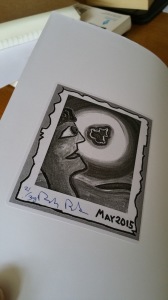See if this rings a bell.
After a few false starts — or a regular bout of procrastination — you finally get down to work. Whether it’s for a day or a week or a month, at the end of this you finally have a first draft of something. Finished. Ready for revision.
During the work, your enthusiasm and passion have been on the increase. You feel you’re tapping into something you always hoped was there but secretly doubted you possessed. The feeling of achievement is enormous. For want of a better term, you feel high.
You set the piece aside to steep and simmer. You give yourself some space and time, knowing that you’ll return to it and start making it even better.
But then comes the crash.
As soon as you step back from the work, the passion fizzles out. The excitement drains. Your enthusiasm dispels like dew on the grass as the sun rises. You wonder what you were thinking. Writing is not for you: the thought of picking up and reading through hundreds of pages of talentless dross is the last thing you want to do.
In Pema Chödrön’s “The Wisdom Of No Escape” she talks of how to deal with these feelings. In her case — in a chapter called ‘Not too tight, not too loose’ — she is referring specifically to the practice of meditation but I think it works perfectly well in relation to the doubts writers feel when confronted with their shitty first drafts. (And remember, all our first drafts are shitty.)
Chödrön writes:
… when we’ve really committed ourselves to practice, when we have some passion for practice and we put our whole self into it, a very curious thing always happens: we get fed up, we lose heart, and we get discouraged.
For ‘practice’, read regular writing.
I’ve experienced this big time in the last couple of months. I finished a draft of a novel and set it aside — for a couple of weeks, I thought. But it has taken me almost three months to work on it again because of all those crazy voices and fears and doubts. Those three phrases — fed up, lose heart, get discouraged — describe perfectly how I felt about my writing.
After the high of finishing the first draft — and the excitement I felt at the story I was building — this was hard to deal with. It has taken a long time for me to get back to the draft. Of course, now that I’ve started working on it again, the excitement builds because writing is what I love doing.
I wish I read this Chödrön chapter sooner. Although she has no particular plan for overcoming the discouragement itself, she recommends simply accepting that this is a by-product of the excitement and success of good practice. Appreciate, too, that this is common to many people.
So I’m not special and different. Damn.
That makes sense: being compassionate to yourself as much as to others is a typically Buddhist approach to an issue. I’m trying.
Tell me how you get through that period of doubt that hits from time to time. Share your recipe for overcoming negativity in the comments. Please — I want to know!
(Balloon photo courtesy of Ryan McGuire at Gratisography)
